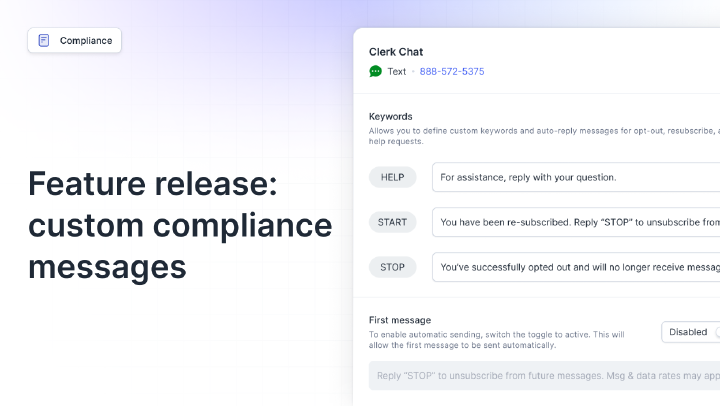CAN-SPAM Act
[kæn spæm ækt]The CAN-SPAM Act is a U.S. federal law that governs commercial electronic mail messages, including certain texts to mobile devices.
It sets national standards to reduce spam by requiring transparency, opt-out options, and accurate information in messages. This applies to businesses sending promotional content.
Why CAN-SPAM Act Matters
The CAN-SPAM Act safeguards consumer inboxes from unwanted spam, promoting trust in digital communications that benefits businesses through higher deliverability and engagement.
Non-compliance risks severe fines, damaging finances and reputation, while adherence builds credibility, encouraging positive interactions. In messaging, it ensures promotional texts reach willing recipients, boosting response rates and loyalty.
It also levels the playing field by standardizing rules, allowing companies to market ethically without fear of unfair competition from spammers.
For customer engagement, compliant practices lead to better data quality and insights, informing strategies that drive revenue. Overall, it supports sustainable growth by balancing marketing needs with consumer rights, resulting in reduced complaints and enhanced brand perception.
How CAN-SPAM Act Works
The CAN-SPAM Act enforces rules through a framework that classifies messages and mandates specific elements for compliance.
Message Classification: Determine if the email or text is commercial (primary purpose is advertising), transactional (facilitates agreed transactions), or relationship-based (updates existing customers).
Header Accuracy: Ensure “From,” “To,” and routing information is truthful and identifies the sender without misleading.
Subject Line Integrity: Craft subjects that reflect content accurately, avoiding deception to lure opens.
Advertisement Disclosure: Clearly label the message as an ad in a conspicuous manner.
Physical Address Inclusion: Provide a valid postal address for the sender.
Opt-Out Provision: Include an easy, cost-free opt-out method, like an email or web link, functional for 30 days post-send.
Opt-Out Processing: Honor requests within 10 business days, without fees or extra info, and prohibit transferring opted-out addresses.
Enforcement and Penalties: The FTC, DOJ, and others investigate violations, imposing fines per message, with criminal sanctions for severe cases.
In application, businesses sending texts via email gateways must apply these, while pure SMS follows TCPA, but overlapping rules emphasize consent and transparency for all channels.
Best Practices with CAN-SPAM Act
Classify Messages Accurately: Evaluate primary purpose before sending to apply correct rules, preventing misclassification fines.
Maintain Transparent Headers: Use verifiable sender details in all communications to build trust and meet legal standards.
Craft Honest Subject Lines: Align subjects with content to avoid deception, improving open rates legitimately.
Provide Clear Opt-Outs: Implement simple mechanisms like one-click unsubscribes, ensuring they work reliably.
Honor Opt-Outs Swiftly: Process requests under 10 days and scrub lists regularly to respect preferences.
Include Physical Addresses: Add valid locations in footers for transparency and easy identification.
Monitor Third-Party Vendors: Oversee affiliates or service providers for compliance, as liability extends to them.
Real world examples
Common misconceptions
It mandates opt-out options but allows sending without initial opt-in, unlike stricter laws such as GDPR.
It covers commercial emails and texts sent to wireless devices via email addresses, though TCPA governs pure SMS.
Fines can reach $53,088 per email, with potential criminal charges for aggravated offenses.
It includes B2B emails, requiring compliance regardless of recipient type.
They must still avoid misleading headers and include addresses, even if primary purpose is transactional.
Related terms
In this article:
Ready to use your business number for text messaging?
Thousands of businesses are already experiencing the power of conversational messaging through SMS. Join us. Free trial and paid tiers available.
Get StartedFAQ
Have questions? We've got answers.
Find what you need quickly and clearly with our most frequently asked questions.
The CAN-SPAM Act is a US federal law enacted in 2003 to curb unsolicited commercial electronic messages. It establishes rules for emails and texts to wireless devices, aiming to protect consumers from spam while allowing legitimate marketing. Objectives include ensuring transparency, providing opt-out rights, and imposing penalties for non-compliance to foster ethical communication practices.
Review message content to classify as commercial or transactional. Include accurate headers, non-deceptive subjects, ad identification, physical addresses, and opt-out mechanisms. Honor opt-outs within 10 days. For platforms like Clerk Chat, built-in features help manage consent and logs for audits, simplifying adherence in texting scenarios.
Fines up to $53,088 per violating message, plus legal fees and reputational damage. Aggravated violations may lead to criminal penalties, including imprisonment. Resources for compliance include training staff and using automated tools, with initial setup costs around $500-2000 for small businesses, offset by avoiding penalties.
CAN-SPAM focuses on commercial emails without requiring opt-in, unlike TCPA's consent mandates for SMS/calls. GDPR emphasizes data protection with stricter opt-in and rights. CAN-SPAM permits initial sends with opt-out; others demand prior permission, making it less restrictive but still essential for US operations.
Yes, it applies to commercial texts sent to wireless devices via email addresses (e.g., number@carrier.com). Pure SMS falls under TCPA, but CAN-SPAM requires similar rules like opt-outs and no deception. Businesses must distinguish channels and comply accordingly to prevent overlaps in violations.
Maintain clean lists by promptly removing opt-outs. Use clear language in subjects and bodies. Audit campaigns regularly for accuracy. Train teams on classifications. Leverage software for automated opt-out handling and tracking, ensuring messages align with consumer expectations for higher engagement.




